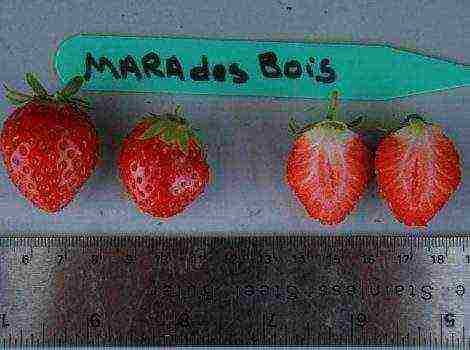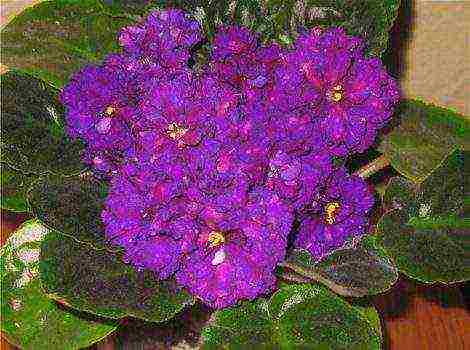Content
- 1 Turnip varieties by maturity
- 2 Sowing turnips in winter
- 3 Sowing turnip seeds in early spring
- 4 The correct timing for planting turnips outdoors
- 5 The best varieties for planting in the Moscow region and the Middle Lane
- 6 Turnip varieties for growing in Siberia and the Urals
- 7 Seed preparation
- 8 Preparing the beds for planting in the garden
- 9 The technology of sowing turnip seeds into the ground
- 10 Post-plant care conditions
- 11 The use of turnips in medicine and cooking
- 12 Growing turnip mothers
- 13 How to grow turnips outdoors
- 14 The best varieties of turnip for the conditions of the Moscow region: photo and description
- 15 Turnip seeds of the sweetest varieties
Our ancestors considered turnips to be one of the main foods. Currently, this vegetable crop is no longer so popular, nevertheless, it continues to be grown in the vastness of our country. What varieties of it deserve attention, how do they differ from each other?
Turnip varieties by maturity
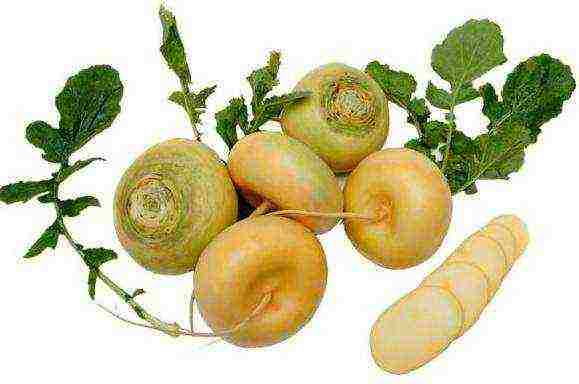
Turnip varieties
One of the criteria for choosing a turnip is the timing of its ripening. There are early, mid-season and late-season vegetables. The growing season of turnips is respectively:
- 45-60 days;
- 60-90 days;
- 90 days or more.
It is also worth considering that the varieties differ in taste - some root crops delight with their sweetness, others have a pungent taste, and still others are bitter. Varieties have been bred that give both root crops and greens (this is a salad turnip). There are also known varieties that provide us only with greens.
The most popular early varieties: Snow White, Granddaughter, Snegurochka, Glasha, Golden Ball, Dedka, Children's Dream, Beetle, Lyra, Luna, May White, Rattle, Presto, Early Purple, Russian Fairy Tale, Sapphire, Snowball, Snowball, Sprinter, Tyani- push.
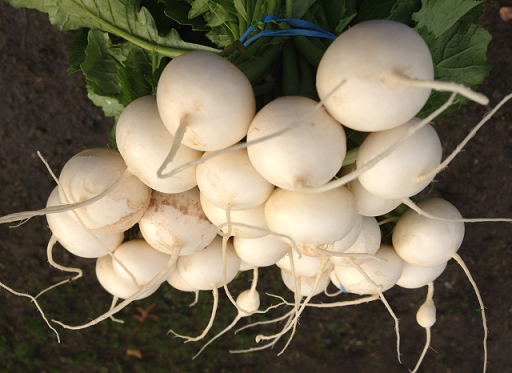
Geisha turnip variety
The Geisha variety is very popular. The plant forms white rounded roots (weight - about 200 g). This turnip is stem resistant. The variety is not afraid of either a drop in temperature or shading. The root vegetables have a very pleasant taste. They are used immediately - the crop is not subject to long-term storage.
Mid-season varieties: White ball, Gribovskaya, Dunyasha, Karelian white meat, Comet, Little Red Riding Hood, White Night, Lepyoshka, Snow Globe, Nurse.
Turnip variety Petrovskaya-1
Turnip Petrovskaya-1 is very popular, although this variety was bred a very long time ago. The plant forms rounded flat roots. The pulp itself is very pleasant to the taste - it is sweet, crunchy, yellowish.
The late varieties are somewhat inferior to the early ones in their assortment. The most interesting are: We pull-pull, Manchester market (MANCHESTER MARKET), Green-top white (GREEN-TOP WHITE).
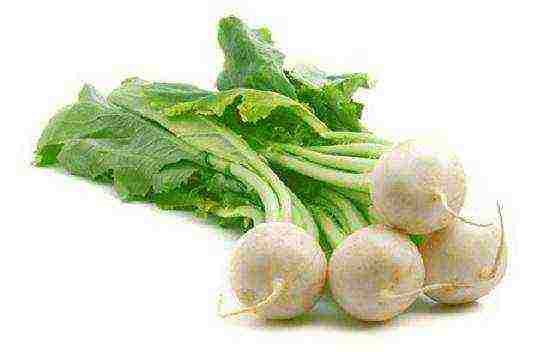
Turnip variety Orbita
Turnip varieties Orbita give good yields. Smooth, white, rounded roots delight with a pleasant taste. Their average weight is 400-500 g. The harvest is stored until spring.
The best varieties of turnips for the Moscow region
Turnip is an unpretentious plant, so its assortment pleases with a variety. All the varieties of turnips listed below for central Russia and the Moscow region are not afraid of frosts, give good yields, and are characterized by a pleasant taste.
The best varieties of turnips: Milanese white red-headed, Petrovskaya-1, May yellow green-headed, Snegurochka, Geisha, Yubileinaya-85.
Turnip variety White night
The White Night variety pleases with its remarkable taste characteristics. The rounded root vegetable is slightly concave in the tail area, the average weight is 500 g. The juicy tender pulp has a sweetish taste.
Turnip varieties for the Urals
In the Urals and Siberia, the following varieties of turnips are grown: Burnt sugar, Petrovskaya 1, Gribovskaya local, May yellow green-headed, Milanskaya white red-headed.
Turnip variety Gribovskaya
Gribovskaya is another old variety. The yellowish skin of the root crop is colored purple on top.The pulp is juicy, firm, pleasant to the taste.
Sweet turnip varieties
Contrary to popular belief, turnip does not always have a specific, far from everyone's favorite taste. You can pick up varieties, the taste of root vegetables is not satisfactory. This category includes the varieties Geisha, White Night, Snow White, Petrovskaya-1, White Ball.

Turnip variety Golden ball
The golden ball is a popular "sweet" variety. The crop can be harvested approximately 50 days after sprouting. A rounded root vegetable with a smooth golden yellow skin and crispy yellowish flesh. Average weight - 60-150 g.
Large turnip varieties
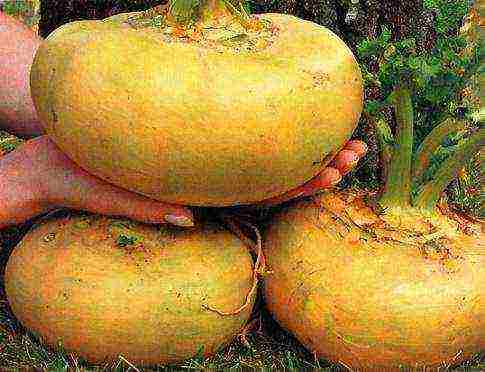
Turnip variety Russian size
A relatively large weight of root crops (500-600 g) is inherent in the varieties: White Night, White Ball, Petrovskaya-1, Milanskaya. But the Russian size turnip can be considered a true record holder. Root crops can weigh up to 2 kg (with good care). They are yellowish in color. The pulp is sweetish, tasty, juicy. The harvest is well kept.
Turnip varieties: root vegetable color
Turnip differs not only in taste, size and ripening time, but also in color. White turnip is represented by varieties Rattle, Lepeshka, Snegurochka. Yellow color is inherent in the varieties Golden Ball, Petrovskaya-1, Russian Fairy Tale, Babka. The pink color of the peel is characteristic of the varieties Milanese pink, Red Sun. The top of the turnip White Night, Granddaughter, Grandfather, Little Red Riding Hood and Early Purple are colored purple.
Turnip: the best varieties
It is difficult to name the best variety of turnip - each of them has its own advantages. It is worth choosing seeds for planting taking into account climatic conditions and your own preferences.
Turnip is a soon ripening vegetable that is packed with vitamins. The best varieties of turnips have a sweet and delicate taste, are not whimsical, and are good for health. The average ripening period is 85 days. Grown in many countries. At a temperature of 18-20 degrees.

For sowing turnips, moist soils are chosen. For a good harvest, it is necessary to sow in early spring, or at the beginning of July. But there are types of seeds that can be successfully sown in winter.
Turnip fruits are early ripening, in the spring it must be planted earlier so that the cruciferous flea does not destroy the fruit. To store fruits in winter, you need to sow in the first half of July, 5-10 numbers. It is not recommended to choose the soil on which cabbage and cruciferous family were previously grown. Good soil will be after potatoes, tomatoes, cucumbers, onions. You don't have to try to grow large fruits. The small fruit is tasty and has many useful vitamins.
Sowing turnips in winter
The land is prepared in the fall. Dig up the soil with a tree hall and fertilizers. The ground above the soil needs to be slightly raised, watered. The garden bed is prepared for sowing before the outside temperature drops below zero. Small grooves are dug, 5 centimeters deep, with a distance of 40 centimeters. When the night temperature drops below zero, you can start sowing winter turnip fruits. We fill the grooves with seeds. In winter sowing, seeds may germinate ahead of time, because of the early thaw, the growing crop will freeze. Advantages of sowing in winter, with an unsuccessful harvest, turnips can be sown again in spring.
In early spring, the bed is covered with a film that needs to be strengthened.
Soon the harvest will rise. Watering and weeding is required. If holes appear on the leaves of the fruit, then cruciferous fleas are eating it. You can treat plants from insects with special solutions. For the safety of turnips from diseases and pests, you must adhere to the following rules. Prepare seeds before sowing. Pull up the weeds. Dig up the ground before sowing the crop. If the turnip is damaged by the fungus, the infected fruit must be removed immediately, otherwise it will infect healthy turnip fruits.
Sowing turnip seeds in early spring
A favorable time for sowing is considered the end of April, beginning of May. The resulting crop cannot be stored in winter. It is believed that the fruits will ripen better if the summer is not hot. Before planting, the seeds are soaked in warm water, then dried, mixed with a small amount of sand.The grooves are made of small depth and size. Seeds are poured, watered, and covered with foil.
Good watering, loosening the soil, removing weeds are the key to a successful harvest. With poor watering, the fruits will grow poorly, the taste will be bitter. Harvested in 6-12 weeks, depending on the selected turnip variety. You can collect fruits that have reached a diameter of more than 5 centimeters. Remove a ripe root crop from the ground with your hands. The tops are cut, dried well, stored in hay for some time, then stored in the cellar. They are placed in boxes with sand so that the fruits do not come into contact with each other. Stored for 2 months.
When growing early varieties of turnips, the harvest is obtained in 50 days.
Consider the best varieties of turnips in the Moscow region. Which are not afraid of frost. Delicious and bearing good fruit.
Petrovskaya-1. Sweet turnip variety, yellow in color. Unpretentious.
Milanese variety. Ripens quickly, pink top, white bottom. The shape is flattened.
Geisha. Even the leaves are edible here. Good for salads. High vitamin content.
White Night. Sweet, juicy pulp. Average weight 450 grams.
Snow Maiden. The fruit looks like a radish and has a white color. Not used for winter storage.
Snow White. Snow-white root vegetable, weighing up to 90 grams. Very tasty, consumed fresh. The leaves are used for salad. Sowing takes place in two terms. In early spring until July.
Granddaughter. Consumed raw. Juicy yellow fruit. Can be stored in winter. It lasts up to 60 days. Average weight 55 grams.
The bug. Reaches ripeness within 55 days. Round shape. The color is purple. The flesh is crispy.
Glasha. It ripens for 45 days, a flat white root crop. Stored for a long time. Used in cooking.
Good. Golden root vegetable. Weighing up to 450 grams. Contains a large amount of nutrients.
White ball. High content of vitamin C. Juicy pulp, has no bitterness. The fruits are white.
Grandpa. Grown in the open field. Ripeness 45 days. Purple. Eaten raw, boiled, or salted.
Dream of childhood. It ripens for 80 days, yellow, weighing up to 200 grams. Possesses cold resistance. Eaten steamed, boiled, salted, baked.
Lyra. It will sing for 50 days. Weighing up to 120 grams. The color of the root crop is white.
Moon. Thin skin. Ripeness up to 75 days. The fruit is round and yellow in color. Eat fresh
in autumn and winter, not afraid of the cold.
May variety. Grown for summer consumption. Ball-shaped, white.
Sapphire. Maturity 35 days. With large green leaves. Contains ascorbic acid and carotene.
Snowball. Ripeness 50 days, round, white, weighing up to 170 grams. Stores well.
Sprinter. The head is lilac, flattened outwardly, white flesh.
Pull push. Ripeness 75 days, yellow bark, weight 135 grams. Stored in autumn and winter.
Russian fairy tale. Round shape, thin skin, yellow color. It matures for 70 days.
Golden ball. An early variety, round shape with white flesh, with a pungent taste.
Comet. Unusual shape, similar to a cylinder, delicate taste, average weight 150 grams. Grown up to 75 days.
Orbit. A round white root vegetable, an average weight of 450 grams.
Purple with a white tip. Round shape, pink, weight 100 grams.
Purple variety. Can be grown in a greenhouse in winter, ripens at 55-65 days, white and sweet pulp, weight 100 grams.
Gribovskiy variety. An old and popular fruit. The skin is yellowish, the top is purple. Tasty and firm pulp.
Burnt sugar. The shape is elongated, with black bark and white flesh.
Tokyo. Loves moisture, requires constant watering. It ripens for 30 days, oval, green leaves.
Tokyo cross. For sowing in spring, small, white fruits. Harvesting in 45 days.
Snowball. It ripens for 80 days, the fruit is round, white, weighing 250 grams, juicy in taste. Shelf life, good for diet.
Russian size. Yellow fruits, weighing up to 2 kilograms, crunchy, with a content of nutrients.
Beanbag. Reaches ripeness for 50 days. A variety for salads weighing up to 200 grams. Round, white, shade-tolerant, keeping well.
Little Red Riding Hood. Unpretentious fruit, ripeness of 70 days, elongated white fruit, tender, tasty pulp, weight up to 300 grams.
Dunyasha. Cold-resistant, weighing up to 200 grams, yellow color. Good for dieting.
Novoagansky variety. Ripeness 70 days. The fruit is white, flat, the flesh is sweet.
Grandma. It matures within 80 days, the shape is round. Golden color, with an average weight of 150 grams, juicy pulp. Stored in winter.
In Siberia and the Urals, the following varieties of turnips are grown well: Petrovskaya 1, Gribovskaya, Maiskaya, Burnt Sugar and Milanskaya.
There are a huge number of varieties of turnip, each variety has its own advantages. Therefore, when choosing, you need to build on the climatic conditions, and your personal preferences.
A turnip, which we learn about in childhood from Russian folk tales, must be able to grow. She does not always please the summer resident with her huge size and mouth-watering appearance. A useful root crop for an unlucky summer resident often goes all into the tops or, due to wormholes, has an unsightly appearance. Therefore, the question of when to plant seeds in open ground is quite relevant.
Subject to the conditions of care and agricultural technology, cultivation is available in the garden in many regions of Russia.
The correct timing for planting turnips outdoors
Short growing season 60 - 80 days lets get over the summer two crops... The first sowing is carried out in the Moscow region in mid-spring - April, early May. In the Urals and Siberia, the terms are practically the same, there turnips are planted in early May, in early spring - in the last days of April.
Planted in the spring root crops do not store for a long time, they are used for summer consumption or are used in the preparation of winter preparations. Commercial root crops are harvested in late June and early July.
Seeds hatch at zero temperature. Young shoots can withstand a night temperature drop of up to -6 degrees. For seed germination, the optimum temperature is 15 degrees.
Second sowing - summer, yields a crop suitable for long-term winter storage. In the central lane, the sowing deadline July (first decade), in the northern regions (Siberia, Urals), summer sowing should be carried out mid to late June.
When sown at a later date, the root crop may not form even when using early maturing varieties. You can calculate the period more precisely: subtract the ripening time indicated on the pack from the date of the expected end of the season.
The best varieties for planting in the Moscow region and the Middle Lane
In the Moscow region, any variety planted at the right time will give a good harvest. Thanks to the frequent rains, the turnip grows excellent at the dachas near Moscow. For winter consumption, you can recommend an old, proven variety - "Petrovskaya-1".
Peter's turnip is suitable for long-term storage... Root crops are yellow with white, juicy pulp. The taste is pleasant, slightly sweet. The shape of the roots is neat, flat-round. The growing season is 70-80 days.
Not a bad variety for the Moscow region Geisha - ideal for summer. The root vegetable is juicy, tasty with white pulp and skin. The leaves are edible and contain beta-carotene. Plus varieties - does not shoot.
Turnip varieties for growing in Siberia and the Urals
An excellent choice for the Ural and Siberian summer residents will be the variety Russian size... Root crops will delight you with their large size (2 kg), excellent classic taste and a long shelf life. Sow the Russian size variety at the end of June, harvest after 2 - 2.5 months.
The variety is ideal for summer consumption. Snowball... Root crops are large, white, without bitterness, recommended for dietary nutrition. The yield of the variety is consistently high. The leaves can be used to make salads.
Seed preparation
It is possible to improve the germination of seed material, to rid it of possible infections in various ways:
- Bubbling during the day.
- Use biostimulant solution for soaking.
- Prepare an infusion of ash (a tablespoon per liter), leave for a day, keep the seeds in a ready-made solution for 6 hours.
- Seeds hold for 2 hours in garlic water... Garlic water protects against bacteriosis. You need to take a tablespoon of grated garlic, pour lukewarm water (½ cup).
- Germinate seeds in a damp cloth... Always moisten the napkin, periodically open it for ventilation.
- Pour the seeds into a small jar, close it with a lid and put in a container with hot water (50 degrees) for 30 minutes.
After any treatment, dry the seeds and only then sow.
 Turnip seeds - very small
Turnip seeds - very small
The seeds are small and dark in color. Sowing is difficult: it is difficult to normalize the number of seeds per unit area, it is difficult to see where it is sown and where it is not. The seeds can be mixed with river sand or sprinkled with potato starch.
Preparing the beds for planting in the garden
The ridge can be equipped in areas where they grew tomatoes, cucumbers, zucchini, corn, beans... It is impossible to plant after radish and cabbage. You can dig up the ridge in the fall by adding a standard set of fertilizers (superphosphate, potassium nitrate, humus) for digging, or in the spring, adding additional urea.
If there is wood ash, it should definitely be added to the soil during the preparation of the ridge. 1 glass is enough per square meter. Turnip responds well to ash. Digging depth of at least 20 cm.
Fresh manure is not added under the turnip. Manure reduces the quality of root crops.
The technology of sowing turnip seeds into the ground
To grow turnips, you do not need to grow seedlings at home in advance.
I row the day before sowing seeds well watered, spending on each square. m for 2 buckets of water. Rows are marked on the ridge, observing an interval of 30 cm between them.
Planting depth on light soils 2 cm, on heavy, clayey soils - 1 cm... Sprinkle the seeds in the grooves with sifted compost or humus. Seed rate per square meter 1 g.
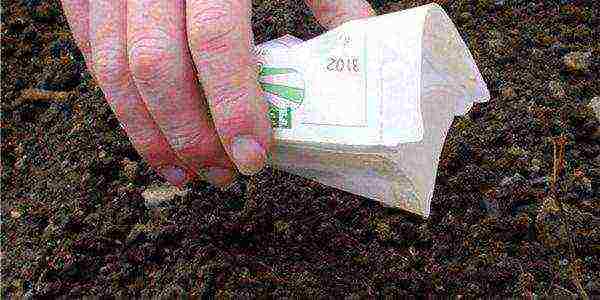 Turnip seeds are planted in well-spilled soil
Turnip seeds are planted in well-spilled soil
Post-plant care conditions
Already on the 7th day, the first green shoots will appear, on the 5th day, if the daytime air temperature is above 15 degrees. The emerging seedlings require watering. You should not expect high-quality root crops if you neglect watering. With a lack of moisture, the roots will be small, not juicy, with tough pulp. Irrigation rate 20 l / m².
Usually turnip sprouts often, after 2 - 3 weeks the shoots are worth thin out... After the first procedure, a distance of 3 cm is left between the two plants. A little later, planting will have to be pulled again. With spring sowing, 6 cm is left between two shoots, with summer sowing - 10 cm.
On average, up to 50 root crops should be placed on each square meter.
The main pest of young turnip - cruciferous flea... The pest is dangerous in the first month after the emergence of shoots. When pests appear, treat the ridge with Iskra.
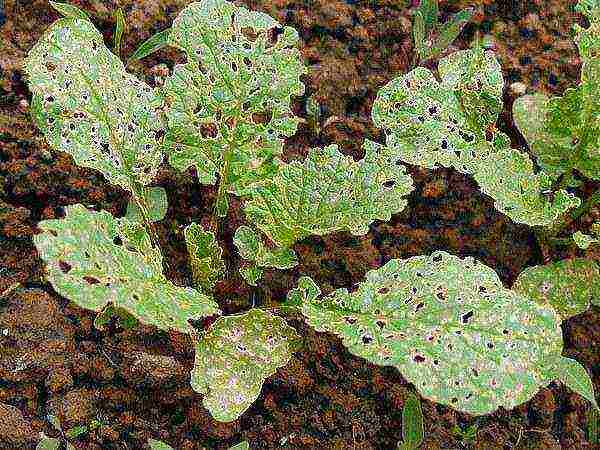 Turnip defeat by cruciferous flea
Turnip defeat by cruciferous flea
The second most dangerous pest of young turnip - cabbage fly... She is scared away from young plantings with tobacco dust, makhorka, hot pepper, ash. Dusting the ridge is carried out the next day after watering.
Turnips are especially good in winter. Cabbage soup with sauerkraut and turnips is a primordially Russian dish that will satisfy even a gourmet. It is not difficult to grow useful root crops for the winter, the main thing is to water them on time.

Care when growing table turnip in the open field will not cause much trouble - this culture is undemanding and cold-resistant, the seeds germinate well without first germinating seedlings.Already a week after sowing, you can see the first shoots, and if you grow turnips as the correct cultivation technique suggests, then in a month and a half you will get the first crop of root crops.
Turnip in Russia has been cultivated for a long time and was widespread. It was eaten fresh, steamed in a Russian oven, boiled, used as a side dish, and before the appearance of potatoes, it completely replaced it.
Turnip belongs to the cruciferous family. It is a biennial root vegetable. In the first year of life, it forms a leaf rosette and a root crop, in the second year - flowering shoots, flowers and seeds.
After reading this material, you will learn how you can grow turnips in the open field, and which varieties are best suited for cultivation in the Moscow region.
The use of turnips in medicine and cooking
Turnip roots are rich in sugars (from 5 to 9%), proteins (up to 3%), fiber, pectin substances, vitamins C (20 mg%), B1, B2, B3, PP, carotene. They contain salts of potassium, calcium, phosphorus, iron, magnesium. Mustard oil gives the turnip root a specific aroma and slightly pungent taste.
Scientific and traditional medicine widely uses turnips as a dietary product to improve the functioning of the gastrointestinal tract, assimilation of food. It has a diuretic, anti-inflammatory, wound healing and analgesic effect. Juice from root vegetables with honey stimulates cardiovascular activity, it is recommended for the treatment of severe cough with colds. If you are growing turnips not for sale, but for your own needs, keep in mind that the use of raw root vegetables is contraindicated in acute inflammation of the gastrointestinal tract.

In cooking, turnips are fried, stewed, baked, added to soups and side dishes, and eaten raw. In many countries, turnip leaves are used in soups and salads. In Russia, turnips were used in different forms. Including fermented like cabbage, and when the bread crop failed, they were added to the dough.
Green young turnip leaves are characterized by a high content of vitamin C, carotene and citric acid, of which there are more than. in beet leaves. In some European countries (Italy, France, the Netherlands), in Japan, the USA and Canada, they are widely used in food, making various salads and soups.
Growing turnip mothers
Turnip seeds are sown on sandy, well-fertilized soils, but manure cannot be applied.
At the beginning of July, the seeds are sown in rows with row spacing of 15-20 cm to a depth of 1.5-2 cm (the seeds are very small, and it is recommended to mix them with sand).
The mother liquors are harvested before the onset of frost. The leaves are cut, leaving tails no more than 1 cm long. Store in sand at a temperature of about 0 ° C.
In early spring, mother plants are planted. When caring for turnip seed plants during cultivation in an open area, it is better to tie the flower stalks to a support. Yellow pods are harvested selectively. They are dried and threshed.
Turnip - cross-pollinated plant. Therefore, mother liquors are grown with spatial isolation up to 700 m.
Turnip seeds can be purchased at specialized stores.
How to grow turnips outdoors
Turnip - early ripening cold-resistant plant. Seeds begin to germinate at 2-5 ° C. Seedlings can withstand frosts up to -2-3 ° C. The optimum temperature for plant growth and root crop formation is 15-18 ° C. Lowering the air temperature to 0-5 ° C during the formation of root crops leads to stalking.
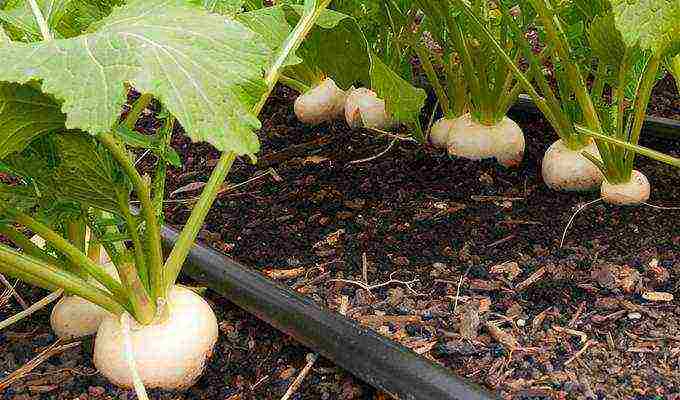
The culture is quite demanding on moisture. In dry conditions, small roots with coarse bitter flesh are formed. It grows on any soil, but it succeeds better on light fertile loams or sandy loams with a neutral or slightly acidic reaction.
It tolerates acidic soils, but it is more affected by the keel, in addition, root crops are worse stored.
Predecessors are recommended cucumber, tomatoes, legumes. Bad predecessors are plants of the cruciferous family - cabbage, radish, daikon.
The soil for planting turnips in open ground begins to be prepared in the fall.For digging, compost or humus 4-6 kg, 15 g of ammonium nitrate and superphosphate, 20 g of potassium salt per 1 sq. m. Turnip reacts well to potash fertilizers. When caring for turnips after planting, it is recommended to bring ash under the plants (100-150 g per 1 sq. M), which provides the plants with potassium and partly phosphorus.
Turnips are usually sown twice a season: early spring for summer consumption and mid-July for winter storage. Sowing is carried out with row spacing of 20-25 cm. The sowing depth is 1-2 cm.
Turnip sprouts about 5-7 days after sowing. In the phase of 3-4 leaves, the plants are thinned out, leaving a distance of 7-10 cm between them. The crops are loosened, destroying weeds and soil crust, regularly watered at the rate of 10 liters of water per 1 square meter. meter. With proper cultivation of turnips in open ground, seedlings are treated from a cruciferous flea, sprinkling the plants with a mixture of tobacco dust and wood ash in equal proportions.
Crop for winter storage is harvested before the onset of frost. Early ripening varieties are ready for harvesting in 35-40 days, late-ripening varieties in 45-55 days after germination. Store in boxes, sprinkled with sand, at a temperature of 0-1 ° C.
The best varieties of turnip for the conditions of the Moscow region: photo and description
Below are photos and descriptions of the best varieties of turnips for growing in the Moscow region:
White Night... Mid-season Czech variety for gardening, home gardens and farms. Technical ripeness occurs on the 70-72nd day. The root crop is white, 10-12 cm in diameter, weighing up to 500 g. The flesh is white, juicy, does not grow stiff. It is immersed in the soil by 2/3.
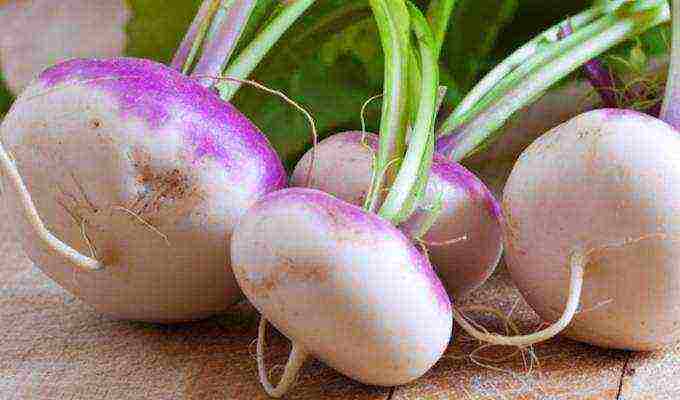
Gribovskaya. Medium early grade. Edible roots are formed 54-60 days after germination. The yield is medium and high. The average weight of the root crop is 200-300 g, the maximum is 2.4 kg. Root crops are flat-rounded, with a concave bottom and a thin long axial root, the bark is smooth, dark purple in the aerial part, and yellow in the lower part. The pulp is yellow, good taste. Relatively resistant to bacteriosis. unstable to keel, cold-resistant, low-flowered, undemanding to soils, good keeping quality.
Golden ball... It is one of the best late turnips with a delicate yellow flesh. Stores well. Medium cold resistant.
Karelian. Mid-season variety. The average weight of a root crop is 300-400 g. Root crops are flat and round-flat, sometimes with a slightly concave bottom. The bark is smooth, white, light green in the aerial part. The pulp is white, juicy, firm, with a satisfactory taste. Relatively resistant to mucous bacteriosis and phomoses. Affected by cabbage fly larvae, unstable to keel.
May white. An early variety for summer consumption.
As you can see in the photo, the shape of the turnip root crop of this variety is spherical, the pulp and bark are white:
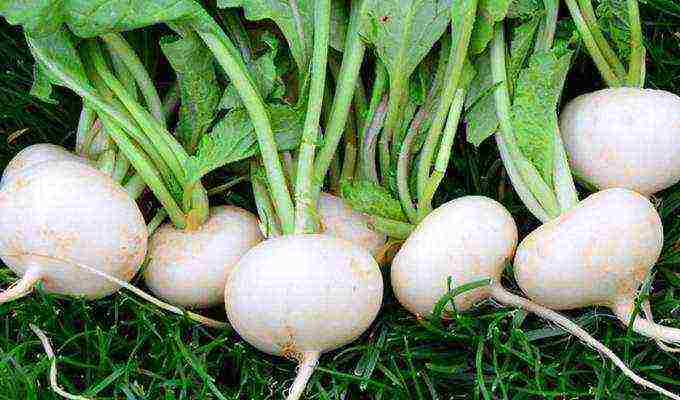
May yellow green-headed. Root crops are flat, less often flat-rounded. The bark at the top is green. The pulp is light yellow. One of the best varieties for the taste of root crops at a young age. Medium keel resistant.
Milanese white violet-headed. Very early ripening (50-55 days) variety with low productivity. The average weight of the root crop is 200-500 g, the maximum in sparse crops is up to 3.6 kg. Taste qualities are high and medium. Not resistant to bacteriosis, moderately resistant to keel.
Presto... A very early variety with roots (6-8 cm in diameter). The seeds of this turnip variety ripen about a month after sowing.
Snowball... Very popular early variety (from germination to maturation 45 days). Root crops are smooth, round, white with dense pulp. The taste is pleasant.
Solovetskaya... It differs from the Petrovskaya 1 variety of green crowns in the aerial part. The pulp is golden yellow. This turnip variety, suitable for the conditions of the Moscow region, is appreciated for its good taste, ability to long-term storage and high frost resistance.
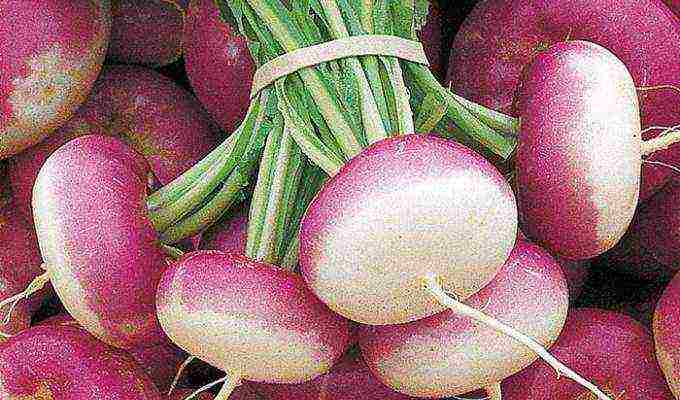
Sprinter... An early variety with smallish, slightly flattened white roots with a purple head. The pulp is white.
Tokyo Cross... An early variety for sowing in May. Root crops are small, white, spherical.Harvested approximately 6 weeks after sowing.
Turnip seeds of the sweetest varieties
The sweetest varieties of turnips are: Milanese red, Namangan Petrovskaya 1.

Milanese red... The growing season is 60 days. Root crops are flat with a slightly concave bottom, excellent sweet taste. The variety is fruitful, disease resistant.
Namangan... Mid-early summer cultivar (July). Root crops are round-flat, white in color. The turnip of this variety has a green head, the flesh is very dense, juicy, spicy and sweet.
Petrovskaya 1. A mid-ripening variety that is most widespread in the temperate zone. Root crops are flat, concave at the bottom. The color of the pulp is yellow (waxy). The growing season is 70-80 days. The root crop protrudes 1/3 from the ground and is easily pulled out. Medium-yielding, good-quality, one of the best in taste. The fruit is flat and flat-round with a concave bottom, golden-yellow skin and yellow, juicy, sweet pulp, weighing 150-400 g. The variety is unstable to keel and relatively resistant to bacteriosis and phomosis.
